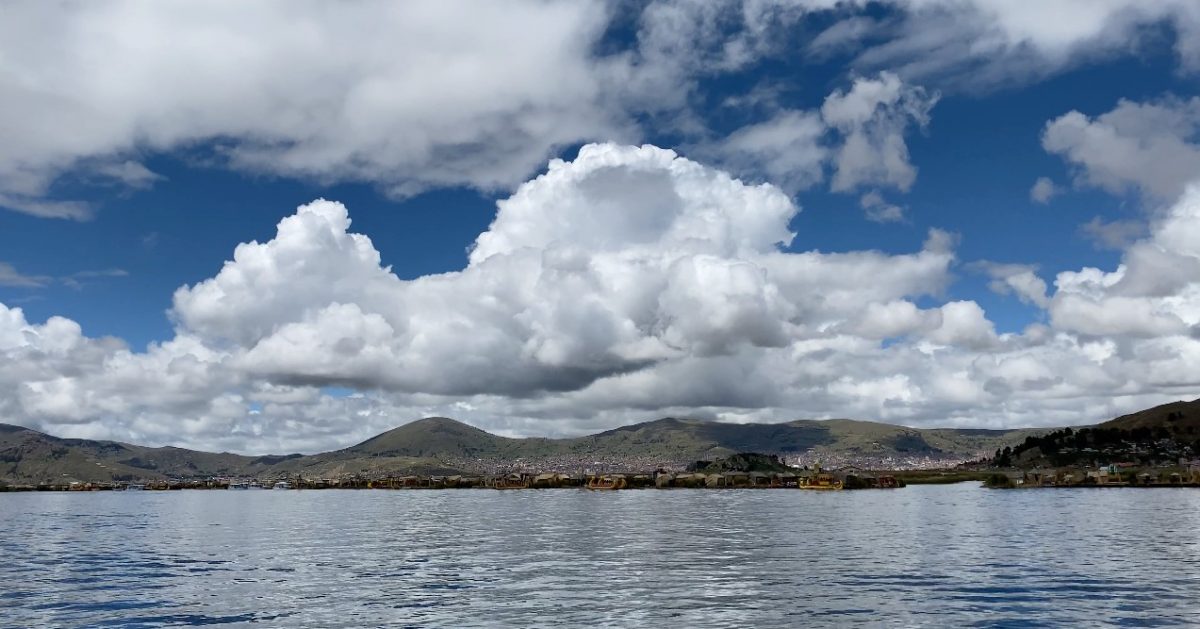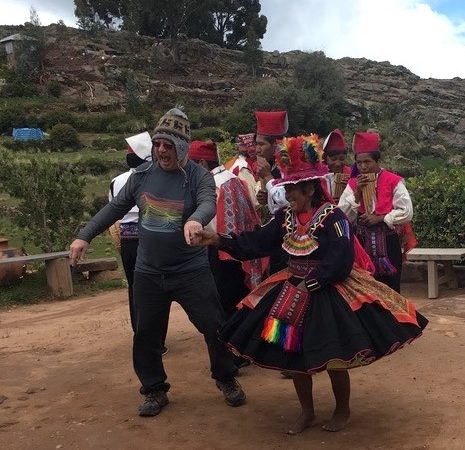We visited a most unusual place – the floating island of Uros. Islands, houses and boats are built from the reeds that grow in Lake Titicaca. They Ayrama people were doing this 1,000 years ago. Our tour guide was Ayrama. Only 2% of the population is. He took us to meet a community on the island.
It was overcast the morning we were to head out. Our hotel in Puno with Lake Titicaca in the back.

Rainy season means a bright beautiful garden.


Most of the tour boats leave from Puno. Our hotel was outside the city limits and had its own, private dock and boat.

We were on a fast, tourist boat for the day. There was an upper deck so went there to get some pics. This is one of the single, reed boats.

There are 160 islands around the lake, all made by hand. There are 4-6 families per island. Tourists come and that greatly helps there economy.

We were greeted by the community. They helped us off the boat as we steeped on to the reed floor. The spongy reeds take a bit of getting use to walking on.

A fish pond. They do not have fruits and vegetables. They have to buy them on the mainland. This is where the tourist dollars are vital.

The head of the community. He welcomed us and began a presentation of how the reeds are incorporated into their life. The demonstration would include hands on demonstations

The blocks of reeds are decayed but solid. They provide the foundation of their home. Here is shows us how they get the root. When the wind blows strong, it churns up the mud allowing them to pull up the root.

Our tour guide, Henry, on the right is Aymara. He provided the translation and further explanations. We were lucky to have him. The root of the reed is a food source. It has enzymes and vitamins. He explained it tastes a little like cucumber.

To get the reeds for building, they need to cut it off and leave the root, instead of just pulling on it. In this way the reed grows back for next time.

The Ayrama people were here before the Incas. They used the floating islands as an escape when the Inca came. Here is is wedging a pole into the block in order to tie the blocks together. In the past they used reed rope. However they now use synthetic as it does not rot.

Using the saw blade to cut it into squares.

They criss cross the reeds on top of the block. If someone in the community wants to move elsewhere, they saw off their part and have a boat tow them to their new place.

Here are models of the different structures they build with the reeds.

We count to three in Ayramian and they lift the “house” up from behind the block.
The wives now display their weavings. They each introduced themselves and then we were paired off. This is Aurora showing a weaving of her life. I went with Aurora and her husband to their house.

She showed me the various weavings she had done. I chose the wall hanging. The hanging depicts her life in the community, from child to adult.

We then boarded one of the reed boats to go to another island. They jokingily call this the Mercedes of boats. For 10 sol each, they row us to another island where there is a café. A few of us headed to the top deck for the view.


Got a coca tea. There was a Titicaca sign for group photo. Our speed boat was waiting by the sign to take us to Taquille Island. It was an hour ride to the island from here. All very organized.

Lake Titicaca is 160 meters in length. It is the highest, navigable lake in the world. Bolivia is on the other side. The border gives about 70% of the lake to Peru. The name Titicaca has various meanings one of which is Rock of the Puma.

Taquille Island has been inhabited for about 1000 years. Our restaurant is up thie hill to the left.

Members of the community greet us and shake our hands. The men have bags containing coca leaves. When they greet each other, they will give each othe some coca leaves from their bags.

The men do all the knitting. They start young. When they ask a girl to marry, they offer her the hat they’ve knitted. If it is well done, she will accept the offer.
The white space hat on the left is for unmarried men. White space symbolizes they only have limited responsibilities. The full colour hat on the right is for married men and shows they have full responsibilities.

They did two dances for us. For the second dance and invited us up to join them. The woman came right up to me so how could I refuse?



We all took our bows and enjoyed the applause. After that I was ready for dinner.

The dinner was simple. A delicious Quinoa vegetable soup that is famous around Peru. Following that was a fresh grilled trout. Perfectly down. The cook was later introduced to us and we thanked her. She is 17 and quite the accomplished chef. They are expanding by building an extension on to the restaurant.

